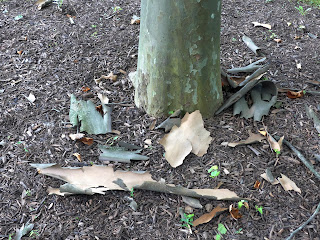Tree Exfoliation
I'm not sure whether this is from an American Sycamore or the American Sycamore/Oriental Plane Tree hybrid, the London Plane Tree. (The most reliable way to distinguish them is that the American Sycamore has single seed balls while the London Plane usually has a pair of seed balls.)
Both trees are perhaps the most prolific bark-shedders of trees in my area. Though bark shedding can occur any time of the year, there's usually a period in the summer when they get most of their shedding out of the way, leaving potentially large strips of old bark on the ground.
These trees have a different bark strategy from most trees. The thin bark that they readily shed may facilitate faster growth than the harder, more permanent bark of most trees. Thick bark might be more important for trees that grow in drier locations, both to retain water better and to potentially protect the tree from smallish fires. It's possible that the discarded bark helps the trees rid itself of hangers-on, like fungi, moss, lichen, and parasites. The bark smoothness probably makes it harder for insects to live there, since they can be spotted by predators fairly easily.




Comments
Post a Comment